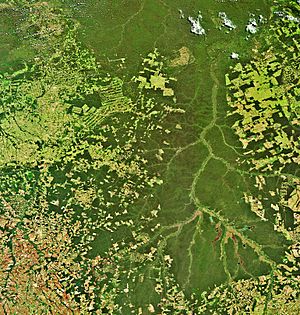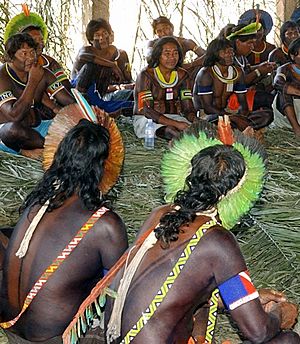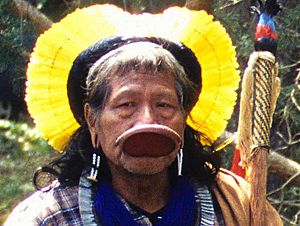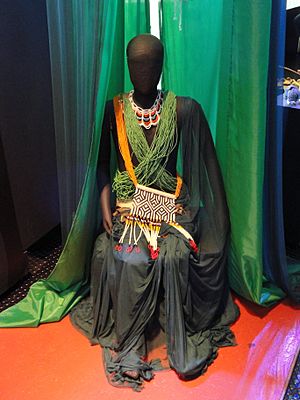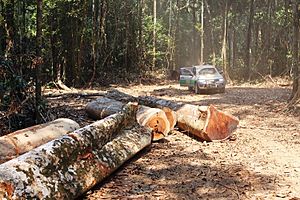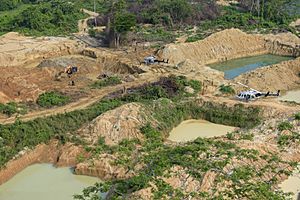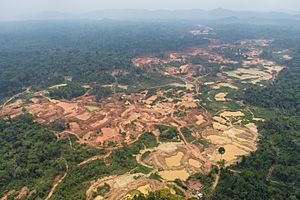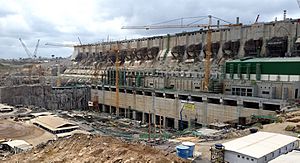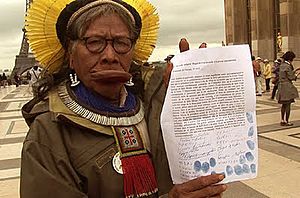Kayapo people facts for kids

Leader of the Kayapó nation, Akiaboro Kayapó
|
|
| Total population | |
|---|---|
| 8,638 (2010) | |
| Regions with significant populations | |
| Languages | |
| Kayapo language |
The Kayapo are an indigenous group living in a huge area of Brazil. Their land is mainly in the states of Pará and Mato Grosso, near the Amazon River and along the Xingu River and its smaller rivers. They are part of a larger group called the Mebêngôkre, which means 'people from the water’s source'. The name 'Kayapo' was given to them by other groups; they call outsiders 'Poanjos'.
Contents
Where Do the Kayapo Live?
The Kayapo tribe lives along the Xingu River in the eastern part of the Amazon rainforest. Their villages are spread out and can have anywhere from 100 to 1,000 people.
Their land is a mix of tropical rainforest and savannah (grassland). It's the largest protected tropical area in the world! It covers over 11 million hectares, which is like 28 million acres. This huge area is home to many endangered animals and plants. The land has small hills and many river valleys. Larger rivers flow into countless pools and creeks, most of which don’t have official names.
In 2010, there were about 8,638 Kayapo people. This was an increase from 7,096 people in 2003. Some of the smaller groups within the Kayapo include the Xikrin, Gorotire, Mekranoti, and Metyktire. Their villages usually have about a dozen huts. A hut in the center of the village is used as a meeting place where the men discuss community matters.
What Do the Kayapo Look Like?
The Kayapo use detailed black body paint all over their bodies. They believe their ancestors learned social skills from insects. So, they paint themselves to look like insects and to connect with the spirits around them. The black paint also helps them hide when hunting in the forest. To mark their path, the Kayapo paint their legs with red pigment that rubs off on the ground. The colors a Kayapo person wears show which tribe they belong to.
Older Kayapo men sometimes wear disks in their lower lips, but this is less common for younger men today. Men also decorate their hair with feathers that spread out like rays, representing the universe. You might also see Kayapo men with rope in their hair. This represents the rope the first Kayapo used to come down from the sky. Traditionally, Kayapo men wore special coverings on their lower bodies.
Because they have more contact with people from outside their culture, many Kayapo now wear Western clothes like shorts. Kayapo chiefs wear a special headdress made of bright yellow feathers. These feathers represent the sun's rays. The feathers come from birds native to their area, like the hyacinth macaw and crested oropendola. The birds in the Amazon naturally have bright colors, so the Kayapo do not dye the feathers.
Kayapo children wear cloth or beaded bands. The colors of these bands represent their tribes. These bands are usually tied below the waist or crisscrossed around the body. When a child gets older, they have a naming ceremony where they wear large yellow headdresses. Kayapo women can be recognized by a V-shape shaved into their hair.
Kayapo Language and Names
The Kayapo people speak the Kayapo language, which is part of the Jê language family. Since the Kayapo are split into many groups, they have different dialects (versions) of their language.
Beauty is very important in Kayapo culture. A beautiful name is seen as a sign of wealth. To hold a naming ceremony, the tribe will sometimes move their camp to find the right materials. They also need to gather enough food for the celebration to give to the newborn's father. Some Kayapo people know some Portuguese, but how much they know depends on their group and how much they have interacted with outsiders.
Farming and Plants
The Kayapo use their land in a way that doesn't harm nature, but it does require a very large area. They practice shifting cultivation. This is a type of farming where they grow crops in one area for a few years, then move to a new spot. They clear new farmland, and the old farm is left to recover naturally.
The Kayapo often use a method called slash and burn. This means they cut down trees and burn them to clear land for farming. These new fields produce the most crops in two or three years, but they can continue to grow food for many more years. For example, sweet potatoes can grow for four to five years, yams and taro for five to six years, and papaya for five or more years.
Old fields are important because many medicinal plants grow there. As Kayapo groups spread out, they also planted crops along trails and in forest clearings. Their trail systems were very long and were used for moving and growing crops along their edges.
The Kayapo use about 250 different food plants and 650 different medicinal plants found around their villages. A type of sweet potato that is a big part of the Kayapo diet is sometimes called "caiapo," after the tribe. It's even grown in Japan under that name and is known for its health benefits. The Kayapo also have trade agreements with a company called The Body Shop.
Protecting Their Land
The Kayapo have many traditional stories, ceremonies, and beliefs that show how important the earth is to them. For the last 30 years, their forest home has been in danger. Mining and logging companies have threatened to destroy the rainforest and the Kayapo way of life.
In one village called Gorotire, the Kayapo made a deal with gold miners. Mining could happen if the Kayapo received a share of the money and their land was divided. At first, the gold mining seemed good. It brought money into the local area, which led to better homes, improved education, and better health.
However, the mining also caused a lot of pollution. This pollution got into the rivers and destroyed local fish populations with high amounts of mercury. Besides environmental threats, the Kayapo's way of life began to change because of more contact with outside groups. This increased contact also led to more diseases. This was a big danger because the Kayapo lived mostly apart from others and had limited access to doctors. Also, fewer natural resources caused arguments between the Kayapo and nearby villages, which often led to long-lasting conflicts. The Kayapo people sometimes used strong actions to make loggers and miners leave their land. They also worked to become a stronger economic force.
In 1987, new land problems came up when the government planned to build several large dams on the Xingu River, including the Belo Monte Dam. These dams were a huge threat to the Kayapo. They could force more than 20,000 people to leave their homes.
Under the leadership of Paulinho Paiakan, the Kayapo organized a big meeting called the Altamira Gathering. This event brought worldwide media attention. The protest happened at the planned site for the first dam in Altamira, Pará. It lasted several days and put a lot of pressure on both the World Bank and the Brazilian government.
The Altamira gathering brought together the Kayapo, other Brazilian indigenous groups, and their supporters. They discussed how to protect the environment and native peoples. The Kayapo demanded information that the government was hiding about the negative effects of the dam. They were worried about their own people and other Brazilians living near the Xingu River, who they felt were not getting fair information.
The Kayapo continued to fight. They used traditional war speeches and dances. At the meeting, they protested the dam while wearing traditional clothes and carrying machetes. One of the most powerful images from this gathering was of Tuíra, a female indigenous leader, angrily waving a machete in the face of an engineer. This moment had a big impact around the world and likely helped delay the dam project.
A famous moment during the protests was when rock star Sting appeared. Sting continued to support the Kayapo in their efforts to protect their land. In 1989, he started the Rainforest Foundation Fund. Three years later, the first privately funded separation of a Brazilian indigenous reserve was made possible.
In 2008, the Kayapo were again threatened by secret government plans to build more dams on their land. The Belo Monte Dam project came back, planned for the Xingu River, which is home to many Kayapo people. The Kayapo people continue to fight against these construction plans.
Sometimes, government corruption makes it harder for indigenous groups and others to resist these projects. Kayapo leaders who protest the dam are often threatened, and some have even been killed by developers and land prospectors. Because of the situation, these actions often go unpunished.
The forest is the Kayapo's home. They depend on its resources for their food and medicine. Rivers are also vital to their way of life. Gold mining in Brazil is polluting these rivers. The proposed Belo Monte Dam project would use huge amounts of resources essential for the Kayapo's survival and would severely impact fishing.
The dam's construction is expected to create many jobs (between 18,000 and 25,000 indirectly). This could lead to a large increase in population in the area. This growth could put even more pressure on the delicate forest and its shrinking natural resources, increasing worries about flooding and deforestation.
Images for kids
-
Kayapó headdress, or ákkápa-ri, from around 1910, at the National Museum of the American Indian
See also
 In Spanish: Kayapó para niños
In Spanish: Kayapó para niños


